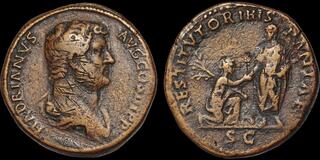| Davissons, Ltd. > Auction 43 | Auction date: 20 March 2024 |
| Lot number: 134 Price realized: 400 USD (Approx. 368 EUR) Note: Prices do not include buyer's fees. | Show similar lots on CoinArchives Find similar lots in upcoming auctions on |
| Lot description: Hadrian. A.D. 117-138. Orichalcum sestertius. 26.45 gm. 31 mm. 'Travel series' issue ('Provinces cycle'). Rome mint. Struck A.D. 130-138. His bareheaded and draped bust right; HADRIANVS AVG COS III P P / Hadrian standing left, holding volumen and raising up kneeling Hispania who shoulders olive branch; rabbit between them; RESTITVTORI HISPANIAE around, S C in exergue. RIC II.3 1866. RIC II 954. Near Very Fine; bold portrait; brown patina; cleaning marks below bust; old marks on Hadrian's bust, with a few similar marks on reverse (a contemporary political statement/damnatio memoriae?). Pleasing example. Scarce. From a collection of high quality ancient coins formed in the American Midwest in the 1950s, carefully sourced from Spink & Son in London, NFA (Edward Gans) in NYC, and Earle Stanton in LA., among others. Hadrian was one of "the most capable emperors who ever occupied the throne and he devoted his whole life to the improvement of the state. His rule was firm and humane and he was also a patron of the arts." (David Sear) He was a philosopher who is renowned for his "Meditations" and inspired Marguerite Yourcenar's "Memoirs of Hadrian." Known as the third of "The Five Good Emperors," Hadrian was a humanist who aspired to create a civil society across the Empire based on Greek philosophical ideals. Throughout his reign he was a patron of the arts, especially invested in architecture and the construction of many beautiful buildings. He spent much of his reign traveling throughout the Empire, dispensing generous handouts to construct new public buildings, projects and settlements. His policy was to strengthen the Empire from within by improving infrastructure, rather than waging wars and conquering enemies without. This policy is clearly seen in Britannia, where in response to a major rebellion, in 122 C.E. he began the construction of Hadrian's Wall to prevent repeat invasions from the fierce tribes inhabiting the harsh terrain and highlands of Caledonia (modern day Scotland) to the north. Today the ruins of Hadrian's Wall still span many miles across the English countryside. Estimate: 375 USD |  |


